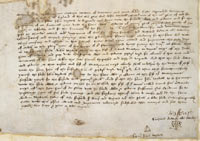 |
 |
 |
 |
 |
 |
 |
|
Byland Abbey: History
Byland Abbey: Buildings
|
Changing times: the reorganisation of the abbey’s estates
It generally made good business sense for the community to lease out its remote lands, which could not easily be brought into any of the abbey’s estates. The community might lease out its lands to lay-brothers or servants of the house. In September 1317, Byland demised ten acres of land in Bretton to John of Dronfield, for twenty years; John promised faithful aid in all business relating to the house and agreed to pay the community three shillings biannually.(34) Granges were often subdivided and might be leased to various members of the same family.(35) The monastery frequently forged good links with its tenants, but relationships could be turbulent and Byland clearly had its share of difficult tenants. One such trouble-maker was William of Atton, who in 1369 was accused by the abbot of making waste in the houses, woods and gardens that the community had demised to him for ten years at Kirkby Malzeard.(36) Another troublesome tenant was William Clayton, who in 1471 claimed to hold rights (‘terms and title of harmhold’) at Byland’s grange of Bentley (Emley). The monks rubbished his claim and notified ‘all Christian people’ that Thomas Allott was the true tenant here, and that he, rather than William, should be supported.(37)
Byland continued to lease out its lands until
the end of the Middle Ages. An agreement was drawn up in 1532 between
Abbot John and
the monks of Byland and Richard Askywith of Osgoodby, regarding
the demise of a third of the monks’ grange at Osgoodby with
its appurtenances for ninety-nine years. It was decided that Richard
should pay the community 6m 8s 10 _ d twice a year. The abbot,
in return, granted Richard and his successors various rights to
hold during this period. Richard and his son agreed to maintain
and repair this third of the grange at their own cost, and to maintain
the straw roofs and plastered walls of the houses, ensuring that
these were handed over to the community in a good state of repair
at the end of the specified period.(38)
In the sixteenth century, on the eve of the Dissolution, the Byland community significantly increased its rents. Given that these were anxious and uncertain times this self-interest is hardly surprising. Following the dissolution of Byland in 1538, the precinct and many of the community’s former lands were sold to Sir William Pickering of Oswaldkirk. William died soon thereafter and was succeeded by his son, Sir William Pickering II. In 1574 the lands passed to the Wottons. Today, farms now stand on many sites formerly occupied by Byland’s granges, such as Oldstead Grange, which lies about a mile to the north-west of the abbey ruins. At some sites earthworks are still visible, for example, in the paddocks at Cams Head Farm, which stands to the west of the abbey. |
